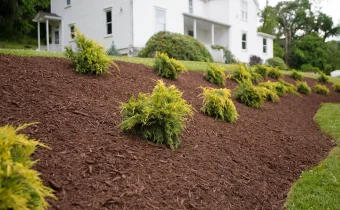We’re answering three questions that we commonly get about mulching including what’s the best type of mulch, should landscape fabric be used, and what time of year should you apply mulch.
What’s the best type of mulch?
When people think of mulch, they usually have something in their mind that looks like shredded up trees. But, did you know that mulch is actually any material, organic or not, that is placed over the surface of soil to conserve moisture, kill weed seedlings, keep soil temperature and moisture normal, or make the garden more attractive – or perhaps all of these!
Let’s explore inorganic mulch, fertile mulch and our favorite – seed free organic mulch.
Inorganic Mulch
 Inorganic mulch helps weeds, but it doesn’t make the soil any more fertile. These types of mulches can be used around shrubs or perennials that are native to the area and don’t require much fertilizer.
Inorganic mulch helps weeds, but it doesn’t make the soil any more fertile. These types of mulches can be used around shrubs or perennials that are native to the area and don’t require much fertilizer.
Examples of inorganic mulches include:
- Rock, stones, pebbles or gravel
- Landscape fabric
- Plastic film
- Rubber
Fertile Mulch
 Fertile mulches are an eco-friendly choice. Some decompose quickly and will insulate your plants, BUT they contain weed seeds.
Fertile mulches are an eco-friendly choice. Some decompose quickly and will insulate your plants, BUT they contain weed seeds.
Examples of fertile mulch include:
- Manure
- Hay
- Straw
- Sewage sludge
We do not recommend mulching your lawn or beds with these products as they are chock full of weed seeds and won’t help with reducing weeds.
Seed Free Organic Mulch
 Since a common goal of mulching is minimize weeds, we prefer using a seed free organic mulch because they do not contain weed seeds.
Since a common goal of mulching is minimize weeds, we prefer using a seed free organic mulch because they do not contain weed seeds.
Examples of seed free organic mulches include:
- Shredded bark
- Wood chips
- Shredded or composted leaves
- Grass clippings from a weed free lawn
- Pine needles
At Dream Greener, our fall mulch of choice is shredded, pine bark mulch. We offer Cherry Brown (our most popular selection), Black, and All Natural (Non-Dyed).
Most of our jobs start at a minimum of 3 yards.
After you’ve chosen a mulch, it’s time to apply it!
Should Landscape Fabric Be Used Underneath Mulch?
Landscape fabric is readily available at home and gardening stores and is commonly used by DIY gardeners when mulching. People use landscape fabric to reduce the amount of weeds that they get, however the opposite is almost always true.
Weed seeds end up germinating on top of and underneath the fabric, making weeding even more of a nightmare than without it. Not to mention, the unsightliness of the fabric if you change your landscaping, have erosion or run off, or if the mulch is thin in any areas. Removing landscape fabric from your beds can be a pain! Most of the time they’re installed with pins and you need to work around the trees, shrubs and flowers that exist in the bed.
For all these reasons, we recommend only using landscape fabric in situations where there is a MAJOR weed infestation, like thistle, but otherwise avoid it.
In addition to debunking common mulch thoughts, most homeowners believe that spring is the time of year to apply mulch to a garden. However, fall is an incredibly important time to walk around and take a look at your beds for their quality of coverage.
When Does Fall Mulching Trump Spring Mulching?
Fall mulching is beneficial for what we call “sensitive plants”. Sensitive plants do not tolerate high winter winds, freezing cold temperatures, little precipitation, salt overspill, or other winter factors well. It could be because they’re new installs, recently transplanted, grafted, or because they’re not the best fit for our 6b hardiness zone.

If you’d like to give them extra protection going into winter, add a layer of mulch to their root zone with 2-3 inches of shredded bark mulch. Ensure that you leave enough space around the stem or trunk of the plant so it’s not smothered on in the shape of a volcano. This could actually be harmful to the plant.
We welcome you to take a look at our Greener Grounds Guide that was expertly designed to help you develop a well thought out maintenance approach to your Pittsburgh lawn and landscaping!



